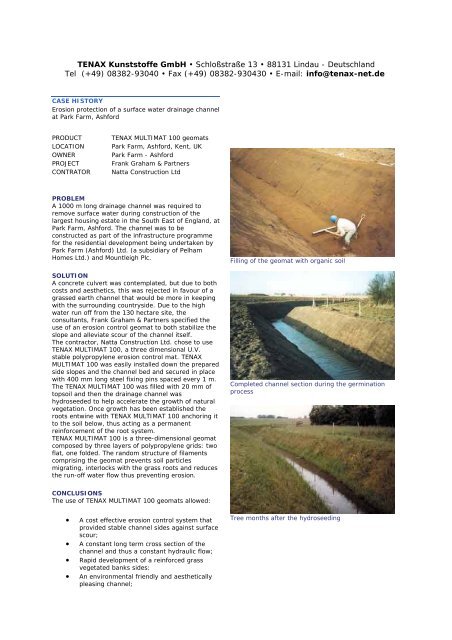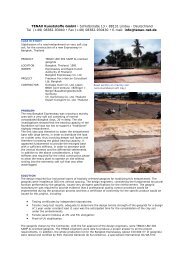TENAX Kunststoffe GmbH - extrudierte Netze und Gitter aus Kunststoff
TENAX Kunststoffe GmbH - extrudierte Netze und Gitter aus Kunststoff
TENAX Kunststoffe GmbH - extrudierte Netze und Gitter aus Kunststoff
Create successful ePaper yourself
Turn your PDF publications into a flip-book with our unique Google optimized e-Paper software.
<strong>TENAX</strong> <strong><strong>Kunststoff</strong>e</strong> <strong>GmbH</strong> • Schloßstraße 13 • 88131 Lindau - Deutschland<br />
Tel (+49) 08382-93040 • Fax (+49) 08382-930430 • E-mail: info@tenax-net.de<br />
CASE HISTORY<br />
Erosion protection of a surface water drainage channel<br />
at Park Farm, Ashford<br />
PRODUCT <strong>TENAX</strong> MULTIMAT 100 geomats<br />
LOCATION Park Farm, Ashford, Kent, UK<br />
OWNER Park Farm - Ashford<br />
PROJECT Frank Graham & Partners<br />
CONTRATOR Natta Construction Ltd<br />
PROBLEM<br />
A 1000 m long drainage channel was required to<br />
remove surface water during construction of the<br />
largest housing estate in the South East of England, at<br />
Park Farm, Ashford. The channel was to be<br />
constructed as part of the infrastructure programme<br />
for the residential development being <strong>und</strong>ertaken by<br />
Park Farm (Ashford) Ltd. (a subsidiary of Pelham<br />
Homes Ltd.) and Mountleigh Plc.<br />
SOLUTION<br />
A concrete culvert was contemplated, but due to both<br />
costs and aesthetics, this was rejected in favour of a<br />
grassed earth channel that would be more in keeping<br />
with the surro<strong>und</strong>ing countryside. Due to the high<br />
water run off from the 130 hectare site, the<br />
consultants, Frank Graham & Partners specified the<br />
use of an erosion control geomat to both stabilize the<br />
slope and alleviate scour of the channel itself.<br />
The contractor, Natta Construction Ltd. chose to use<br />
<strong>TENAX</strong> MULTIMAT 100, a three dimensional U.V.<br />
stable polypropylene erosion control mat. <strong>TENAX</strong><br />
MULTIMAT 100 was easily installed down the prepared<br />
side slopes and the channel bed and secured in place<br />
with 400 mm long steel fixing pins spaced every 1 m.<br />
The <strong>TENAX</strong> MULTIMAT 100 was filled with 20 mm of<br />
topsoil and then the drainage channel was<br />
hydroseeded to help accelerate the growth of natural<br />
vegetation. Once growth has been established the<br />
roots entwine with <strong>TENAX</strong> MULTIMAT 100 anchoring it<br />
to the soil below, thus acting as a permanent<br />
reinforcement of the root system.<br />
<strong>TENAX</strong> MULTIMAT 100 is a three-dimensional geomat<br />
composed by three layers of polypropylene grids: two<br />
flat, one folded. The random structure of filaments<br />
comprising the geomat prevents soil particles<br />
migrating, interlocks with the grass roots and reduces<br />
the run-off water flow thus preventing erosion.<br />
CONCLUSIONS<br />
The use of <strong>TENAX</strong> MULTIMAT 100 geomats allowed:<br />
• A cost effective erosion control system that<br />
provided stable channel sides against surface<br />
scour;<br />
• A constant long term cross section of the<br />
channel and thus a constant hydraulic flow;<br />
• Rapid development of a reinforced grass<br />
vegetated banks sides:<br />
• An environmental friendly and aesthetically<br />
pleasing channel;<br />
Filling of the geomat with organic soil<br />
Completed channel section during the germination<br />
process<br />
Tree months after the hydroseeding
• An increased resistance to hydraulic water<br />
flow with minimal erosion, for vegetated<br />
slopes, up to a flow rate having a limit<br />
velocity of 6.0 m/s<br />
Schematic section




